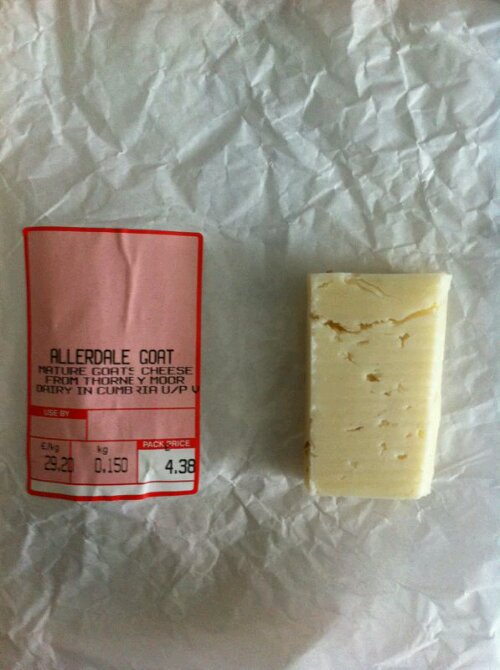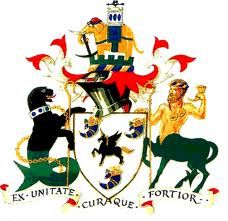Following last week’s Walk in Woolton (Part 2) and my visit to The Liverpool Cheese Company this week I decided to buy a piece of one of the cheeses I gave as an example - Allerdale Goat’s Cheese (AGC from now on). So it was another walk and back to the shop. Now I’d never heard of or had AGC or in fact any goat’s cheese before so this was a bit of a leap into the unknown. I hoped, as the cash register closed, that I would not regret the purchase. As soon as I got home the wrapping was off and I sampled my first ever piece of AGC.

Yep I forgot to take the pic before I started eating so this just what was left by the time I remembered. No, I didn’t regret the purchase – it was all about a new experience. It tasted fine but I’ll have to see if it grows on me sufficiently to push Shropshire Blue off the no.1 spot in my “Cheese Charts”.
Anyway the name got me thinking along the lines of what’s Allerdale Goat’s Cheese all about. Much has been made in the UK media over recent years about how kids don’t know where their food comes from; some don’t know what meat comes from cows, sheep & pigs; some didn’t even know meat came from any animals at all. I guess it’s city living and busy parenting (little time for the kids) that has something to answer for. So, with my AGC I was curious: where is the place it comes from, how’s it made, how did it get to the shop, etc?
Let’s start with the place where it is made – Thornby Moor Dairy in Thursby. Here’s where the dairy is:
http://www.visitcumbria.com/simon/croftonhall-9200b.jpg
You might have to click on the visitcumbria Thursby website search results if your browser doesn’t go directly to the image. (once you’re there, it’s 4th pic on the site.)
The dairy was started in 1979 by Carolyn Fairburn and it moved to the present site in Thursby in 1994. The dairy is in Allerdale which is not a single place but an area that was formed back in the 1970s by merging the districts of Workington, Maryport, Cockermouth, Keswick & Wigton. All these places, as you look at a map of England, are in the far north-west and to the south-west of Carlisle (which is about 10 miles south of the Scottish border).
Here’s a map showing the Allerdale area highlighted: http://www.flickr.com/places/info/12695900
Now, in common with blogs earlier this year (21.8.12 & 19.9.12), I decided to start with a check on the coat of arms. These usually give lots of info about how a town/city sees itself in terms of historical and current associations using heraldic symbols to represent those various characteristics. Here’s the one for the Borough of Allerdale:

Let’s have a look at this somewhat cluttered image. Starting with the motto, in Latin of course: Ex Unitate Curaque Fortior. It means, according to the Heraldry of the World website, “Strength through caring and working together” although the borough’s own website is not as exact in its translation. Anyway it’s a good motto isn’t it? Something that I’m sure they hope will instil a sense of both commitment & community. Now there is a lot going on in their coat of arms picture; much of the imagery relates to characteristics, history and geography of the area which they want to represent. A quick run down starting at the top reveals some interesting info and some dodgy explanations from a site which should know better:
The weather vane (supposedly ship-shaped?) represents maritime connections, shipbuilding and more recently wind power technology in the district. This sits on top of a howdah - a seat fixed on an elephant. The howdah has 3 blue ovals representing thrushes’ eggs that refer to the town of Wigton where the council meetings were held originally. The elephant represents integrity & unity and the colours the towns of Egremont, Senhouse and others. Its trunk is holding a pick-axe to represent mining in the district. The green crown under the elephant represents civic authority. Heraldic terminology keeps the Latin words for left & right sinister & dexter. I did a bit of Latin at school so recognised these. However, I must point out that the Heraldry of the World website has got the part about the creatures supporting the shield completely wrong! We read there that “the sinister supporter (of the shield) is a centaur”. Now just look at the picture – the centaur, which is half man half horse, is clearly on the right (therefore dexter). It symbolises the Roman past of the area but also hospitality & wisdom. (I’m struggling a bit with that as centaurs, as far as I remember, were not noted for the last two qualities but maybe I’ve got it wrong.) Note also around the centaur’s neck the two medallions depicting drama: one for tragedy and one for comedy. Now given they got the sinister (left) bit wrong it follows they also got the dexter (right) bit wrong; they quote, “the dexter supporter is a sea dog” – no it isn’t! So let’s be clear – on the left (sinister) is a sea dog and on the right (dexter) is the centaur. (The Borough’s own website also has it incorrectly so someone copied from someone and it highlights the dangers of copying info without checking the verbiage; I have emailed the council and will report back next week if I get a reply from them. I’m not holding my breath.) Next is the sea-dog on the left (dog with mermaid-like tail) symbolising the marine activities of the area. The collar & chains refer to shipbuilding & mercantile marine activities. The name sea-dog refers to Fletcher Christian (of Mutiny on the Bounty fame) and the colours used reflect those in his coat of arms. Pitcairn Island is only 2 miles (3.2km) long by 1 mile (1.6km) wide and currently has a population of around 50. Its administrative headquarters are in Auckland (New Zealand) 3300 miles (5310km) away. With an ageing population the Island is looking for immigrants – short or long term - who are crucially self-supporting. If you fancy it get going folks as 2013 will see some possible employment opportunities opening up there. (Check out the website: http://www.visitpitcairn.pn/) Daily accommodation rates are in the region of $70-$120 and can include full board, meals & laundry. (Again check out what’s on offer: http://www.visitpitcairn.pn/visitpitcairn/accommodation/index.html) but don’t forget to add on the cost of getting there!
In 2005 Fletcher Christian’s great-great-great grandson, Tom Christian, left his home in the Pitcairn Islands and visited Fletcher’s birthplace, Moorland Close Farm in Cockermouth. (Interestingly, the Government of the Pitcairn Islands Website: http://www.government.pn/Pitcairnshistory.htm tells us that Fletcher Christian went to school with William Wordsworth. Now this could be slightly misleading with you imagining them running round the playground together. The truth is that Christian attended the same school - Cockermouth Free School, founded in the reign of Charles II - but was 6 years older than WW so it’s unlikely they played together. Anyway I bet you didn’t know that!) Here’s a pic of the plaque from the school: http://www.flickr.com/photos/up70mm/5064975794/ Sadly they got the year wrong – the Mutiny was 1789. At FC’s birthplace you can see they got it right – check the pic on Flickr:
http://www.flickr.com/photos/up70mm/5071478465/in/set-72157625126119032/
Back to the coat of arms, the crook the sea dog is holding represents sheep-rearing and rambling. Finally the shield and what’s inside it. In the centre is Pegasus representing inspiration, swift communication, and rivers and lakes. Pegasus is said to be the inspirer of poets, engineers & inventors. The three horns are called cornucopias and out of them grow wheat, corn, bluebells, daffodils etc. The keen-eyed among you might have noticed this Pegasus has a unicorn. Why? Well it’s to represent yet more qualities of the area – purity & healing. So you can see they managed to cram an awful lot into that image.
A slight digression here as the town of Caldbeck (in Allerdale), lying just 7½ miles south of the place where my cheese is made, was home to the eponymous hero of the old English folk song D’ye ken John Peel; (for D’ye read “Do you” or “Do ye”). A number of versions of the lyrics arose initially due to oral transmission. Here’s the opening verse which I and many others learnt at (primary) school:
D'ye ken John Peel with his coat so gay?
D'ye ken John Peel at the break o' day?
D'ye ken John Peel when he's far, far a-way.
With his hounds and his horn in the morning?
One version of the 3rd verse goes like this:
Yes, I ken John Peel and his Ruby, too!
Ranter and Ringwood, Bellman so true!
From a find to a check, from a check to a view,
From a view to a kill in the morning.
Did you spot the James Bond film in there?
Caldbeck is also the place where the well-known UK haulage firm, Eddie Stobart, began life as an agricultural contractor in the 1940s threshing corn and later (in the 1950s) spreading slag for fertiliser. Today the company’s general haulage operation, with its origins in 1970, has over 2,500 trucks (tractor units), thousands of trailers and a number of specialised divisions: rail, container, biomass, logging, car transporters & 2 airports. There have been three television series on a national network about different aspects of the company’s business and its employees. Some people spot trains, some aeroplanes but this haulage company has a fan club whose members are regular “Eddie spotters”: they collect the names that appear on the trucks – each truck has a female name and the first one was Twiggy named after the 1960s model. The firm’s official fan club has around 25,000 members and given that there will be spotters not in the fan club it’s possible there are thousands more out there checking the names of the trucks as they go by.
Anyway, back to the cheese. It’s made from raw milk produced by the owner’s herd of goats. Perhaps I ought to visit some day and thank the goats. It does, though, have to be matured for 5 months. Goat’s milk is believed to be one of the oldest sources of dairy produce in the world and more similar to human milk than cow’s milk.
And all that from my little piece of cheese!
No comments:
Post a Comment